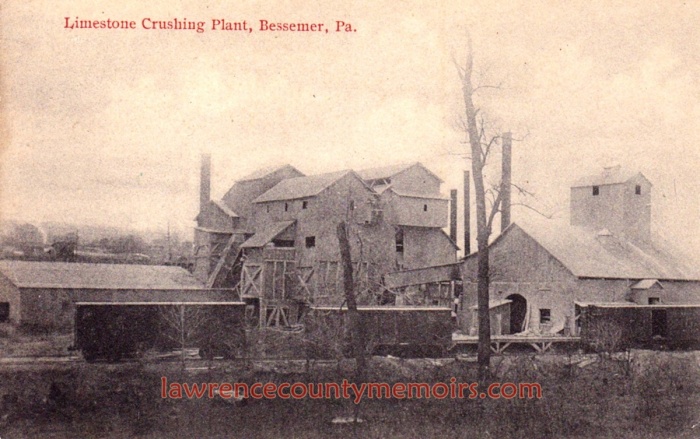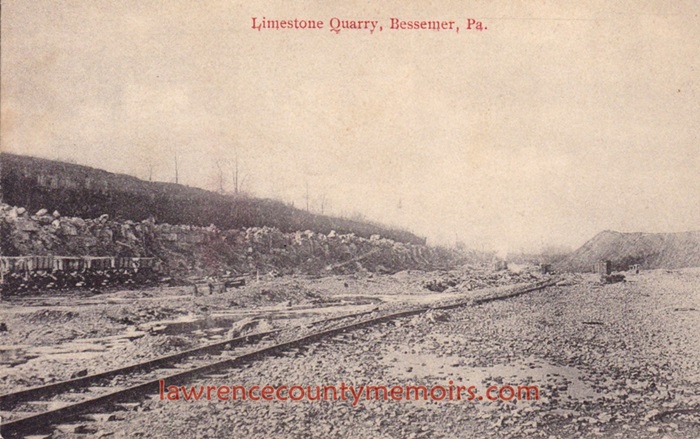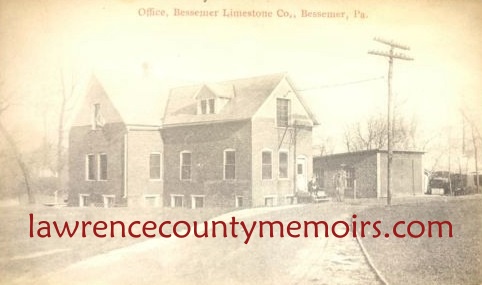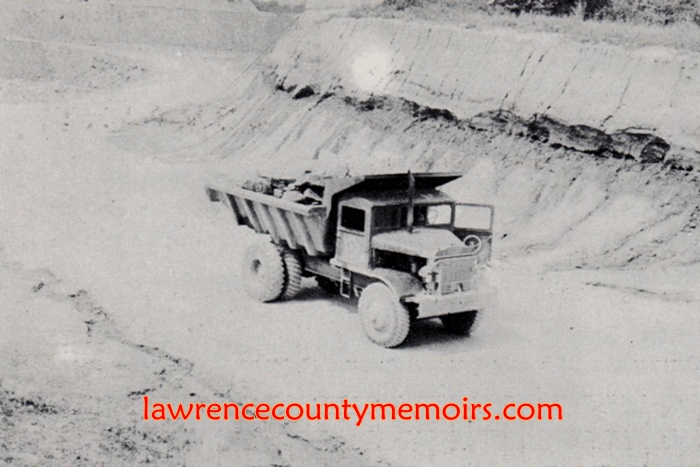The Bessemer Limestone Company (BELCO), which initially may have been known as the Tod, Butler Company, was organized by budding industrialist Joseph G. Butler Jr. (1840-1927) in about 1885 to mine the abundant limestone fields in the rural hills south of the settlement of Hillsville in western Lawrence County. Butler was previously employed by the Youngstown-based Brier Hill Iron & Coal Company, which was founded by the late David Tod (1805-1868) – a skilled lawyer, wealthy coal and steel magnant, and former Governor of Ohio. Butler was financially supported in his new venture by a group of wealthy iron and steel manufacturers from Wheeling, West Virginia.
Coal had been mined commercially in the Mahoning Valley area since the 1830’s, but large scale limestone mining was a fairly new but growing venture in the 1880’s. Large amounts of limestone were necessary to produce pig iron, which in turn is further refined to make steel. The steel making industry was still in its infancy and the high quality Vanport limestone in the region was of great value to many steel company executives. Other competing mining firms, such as Carbon Limestone Company, were already in operation in the same general area and a handful of others would follow.
BELCO enlisted a host of Swedish but also Finnish, Slavic, and Italian immigrants in its mining operations, around which sprang the little settlement of Bessemer in North Beaver Township. The company and settlement name of Bessemer came from Sir Henry Bessemer, the English inventor of the Bessemer process that utilized limestone in the manufacturing of steel. Initial operations were crude with “men and mules” doing most of the work, but things progressed into the modern times with the use of engine-driven machines beginning soon after 1910. Extensive mining operations by BELCO and other outfits produced a host of deep quarries that still dot the landscape around the Bessemer-Hillsville area.
In 1889 the Pittsburgh, Youngstown, and Ashtabula Railroad (PY&A), under the control of the Pennsylvania Railroad (PRR), had opened an extension off its mainline at Covert’s Crossing to serve the industries at Bessemer and particularly BELCO. To avoid confusion with the town of North Bessemer near Pittsburgh the PY&A/PRR called its new Bessemer-based freight station “Walford.” Years later, in 1921, the Pittsburgh & Lake Erie Railroad (P&LE) also opened a short extension off its existing secondary track from nearby Hillsville.
The limestone mining operations were a major success for BELCO and the company steadily expanded its operations over the years. In addition the region around Bessemer was rich in other natural resources to include coal, clay, sandstone, shale, and oil. The shale rock, normally hauled away as overburden, had a high quality of clay and BELCO decided to start utilizing it to produce bricks as well. With this the Bessemer Brick Company, a subsidiary of BELCO, was born.
In late 1902 the new company opened a “face brick” plant along West Poland Avenue in Bessemer, and followed that up by opening a large “paving brick” plant on East Poland Avenue in 1907. These two plants, expanded significantly in the next few years, were a major success. Other subsidiaries, which sold limestone byproducts for agricultural or construction purposes, were also established.
The village underwent rapid expansion as well and was officially incorporated as the Borough of Bessemer in July 1913. The humanitarian-minded Fred R. Kanengeiser (1878-1965), the vice president and general superintendent of BELCO who is known as the “father of Bessemer,” was largely responsible for the early growth of the town.
In early 1917 BELCO sold of its entire brick manufacturing interest to the Canton-based Metropolitan Brick Paving Company, which went on to become one of the largest and most well-known brick making companies in the world. Metro Brick immediately upgraded operations at Bessemer and by the early 1920’s the two plants, managed by superintendent R. C. Wallis, were producing record numbers as far as production goes.
BELCO, with headquarters in Youngstown, returned to concentrating on limestone mining but in July 1919 the firm, with intentions to erect a massive cement making plant, reorganized itself as the Bessemer Limestone & Cement Company. Joseph G. Butler Jr., at the age of seventy-nine, served as the first President of the new company with Fred R. Kanengeiser filling the role of general manager. Butler, a noted philanthropist and lover of American art, ascended to Chairman of the Board in 1921 and went into semi-retirement. He was succeeded in the role of president by John Tod, the grandson of industrialist David Tod.
The New Castle News of July 17, 1919, reported, “Erection of the mill will mean a big boom for Bessemer, which is already one of the liveliest little towns in this end of the state. The new plant and quarries will employ several hundred men.” Construction of the massive facility soon got underway on East Poland Avenue between the two plants of Metro Brick.
The cement plant, although not fully completed, started producing its first batch of cement starting in late October 1920. A New Castle News article of October 30, 1920, reads, “It will be of great interest to know that the company will construct plant buildings made out of its own manufacture of cement. The cement producing machinery has been installed but the walls of the buildings have yet to be constructed. Only such cement as was needed to construct the foundation of the machinery was purchased the balance needed for the construction of the plant buildings to be produced by the machinery of the company, cutting down the expense of constructing the plant and demonstrating the quality of cement manufactured by the plant.”
The peak years of productivity at the Bessemer Limestone & Cement Company, as well as for Bessemer as a whole, were the early 1920’s. In January 1927 the Standard Slag Company, an outfit established in Youngstown in 1914, acquired control of the Bessemer Limestone & Cement Company. The cement plant, now under the control of industrialist and philanthropist Leon A. Beeghly (1884-1967), was upgraded in 1930 but was about to face the tough times of the Great Depression.
The company staggered for a time and endured financial difficulties in the early 1930’s. It was even closed down at short stretches due to lack of orders. For much of the decade it operated at 1/3 capacity, but by the early 1940’s was back to full strength. About 300 men were employed at the plant for much of the 1940’s and 1950’s. By the 1960’s the town of Bessemer, once a thriving center of activity, was steadily returning to its sleepy roots as the local economy weakened. In late 1963 the town was dealt a severe blow as Metro Brick permanently shut down its operations in Bessemer.
In 1960 the Bessemer Limestone & Cement Company was merged into the Diamond Shamrock Corporation, a rapidly expanding company based in Louisville, Kentucky. In 1968, to comply with federal regulations, that company divested itself of the Bessemer cement plant and sold it to the Louisville Cement Company for $20 million. The plant was closed in late 1982 and its 220 employees were furloughed. The plant was fortunately reopened, with a reduced workforce, when the Standard Machine & Equipment Company of Uniontown purchased it in April 1983. The French cement firm Ciments Francais acquired the plant two years later and rebranded its North American operations as ESSROC in 1990. The ESSROC division was acquired by the wealthy Italian firm Italcementi Group in 1992.
The cement plant in Bessemer, though at dwindling production, remained in operation into the next century. In late April 2009 the Italian-owned ESSROC ceased accepting new orders at this plant. The existing supply of raw materials was manufactured into cement, and when that supply was exhausted the plant was basically shuttered in late 2009. The plant’s 113 employees were all slowly furloughed in stages during that time. A skeleton crew of workers stayed on for a while afterwards to help “mothball” the plant. The future was not very promising but ESSROC and its local employees held out hope that the plant could be reopened at a later date.
In 2011 the U.S. Environmental Protection Agency (EPA) began a major initiative to reduce air pollution from cement plants across the country. Among its targets was ESSROC, the eighth largest cement producer in the country with six plants in Pennsylvania, West Virginia, Indiana, and Puerto Rico. On December 29, 2011, it was announced that ESSROC, as part of a settlement due to violations of the Clean Air Act, would pay a $1.7 million dollar penalty, invest $33 in pollution control techniques at five of its cement plants, upgrade old engines on some of its heavy vehicles, and close the idle cement plant at Bessemer. The once-thriving town of Bessemer was dealt another unfortunate blow for a town already mired in tough economic times. However, the proliferation of well drilling to extract Marcellus Shale natural gas, and all the dangers and issues it poses, has since become the focus of a renewed economic outlook in western Lawrence County.
Italcementi Group (and its subsidiaries ESSROC and Lehigh Hanson) was merged into German cement company HeidelburgCement AG in July 2015. Due to federal trade regulations this global cement manufacturing giant was forced to divest itself of some its holdings in the United States. In the summer of 2016 some of the old buildings at the Bessemer plant were demolished – apparently in connection with an upcoming business transaction. In November 2016 the HeidelburgCement company sold part of the Bessemer facility, as well as about eight other cement plants, to Argos USA, a subsidiary of Argos Cementos of Columbia. Argos paid about $1.2 million and took control of about 14 acres (of 114 total) of the sprawling facility at Bessemer, including the main plant buildings. By early 2017 signs mentioning “Argos – Bessemer Terminal” were hung at the locked main gates to the Bessemer plant, but little actual news has been released as of yet.
 The Bessemer Limestone Company (BELCO) was organized by a group of steel manufacturers in about 1887 to mine the abundant limestone fields in the rural hills of western Lawrence County. Large amounts of limestone were needed for various uses including to produce pig iron, which in turn is further refined to make steel. (c1907) Full Size |
 One of the extensive limestone quarries prevalent in the hills between Bessemer and Hillsville. (c1907) Full Size |
 (Oct 1909) |
 Main office building of the Bessemer Limestone Company. (1910) |
 Around the extensive mining operations sprung the small settlement of Bessemer, which was incorporated as a borough in 1913. BELCO was reorganized in July 1919 as the Bessemer Limestone & Cement Company, and a massive cement plant on East Poland Avenue (pictured above) commence operations in October 1920. (c1925) Full Size |
 The region around Bessemer was rich in resources to include limestone, coal, clay, sandstone, shale, and oil. Due to an abundance of other raw materials BELCO later branched out into the brick and cement making industries. Mining operations produced a host of deep quarries that now dot the landscape around the Bessemer-Hillsville area. The above photo shows mining operations taking place just north of Bessemer in what became known as Lake #5. (c1905) Full Size |
 Blasted shale rock is removed from a BELCO quarry near Bessemer so mining operations can get to the limestone below the surface. An electric shovel made by the Marion Steam Shovel Company, renamed as the Marion Power Shovel Company in 1946, is loading a heavy duty truck. (1945) Full Size |
 BELCO relied on railroad cars to remove the overburden stone and limestone for many years, until heavy duty trucks – some made by the Euclid Road Machinery Co. of Cleveland – were phased into use in 1941-43. (1945) Full Size |
 These photos depict further images of the Euclid trucks and the Marion shovel. (1945) Full Size |
 An old postcard of the office building of the Bessemer Limestone & Cement Company, located on 2nd Street in Bessemer. In the early days the company employed as host of Swedish, Finnish, Slavic, and Italian immigrants in its mining operations, as well as its brick and cement making plants. (c1925) Full Size |
 An overhead view of the sprawling cement works in Bessemer. This once thriving facility was the lifeblood of Bessemer. (1982) |
 (Jan 2017) |  (Jan 2017) |
 (Jan 2017) |
 (Jan 2017) |  (Jan 2017) |
 Some of the old buildings of the cement plant in Bessemer were demolished in 2016 – apparently in connection with the pending sale of the facility. (Jun 2016) |












Comments
Chris Pavkovich #
My inlaws lived just down the street from this plant. Dust covers everything. LOL
Karen Stemac Gorman #
You must know the PERCIC family. Mary & Ozzie (Walter) Percic were my aunt and uncle. Linda Percic Romano and Barbara Percic Chierici are my cousins!! They lived right near the plant. Loved the 4th of July in Bessemer….had the best parades. So many other Percics…..Uncle Richard & Aunt Irene. My Grampa …….
Wally Romano Jr #
I remember growing up across from the main entrance to the plant. Never forget those days when we would stand in the front yard to wait for our grampa ( Ozzie ) to get done with work so we could help him carry his lunch bucket home.
Bill Cwynar #
Remember fishing at the Bessemer Rod and gun club lakes and Johnson club lake in the 70’s as a kid. Great memories.
stewart w huston, jr #
I grew up in Enon Valley, Pa. and i went to Bessemer Grade School.
Henry Nofsker Jr #
Went to work for martin trucking 1977 and hauled cement out of the Bessemer plant untill essrock shut down.
DuWayne Taylor #
Went work Mitchell Transpt April 1975.Hauled cement out of bessemer cement until 2003 when I RETIRED from Venezia hauling. Made good money there.Sorry to see plant closed. 8/17/2014 11:00 AM.Twenty eight good years.
John Cifra #
My Dad worked there driving the big Euclids, he referred to them as “Yukes”. We lived in Edinburg and I attended school in Hillsville.
peter johngrass jr #
I was out of the area and lost contact with many of the workers at the plant who I went to Mohawk with so I lost my father who passed away about 3 years ago and he had well over 30 years at the plant. I am wondering if there is a life insurance on the employees who retired that passed away I know that the company changed hands a couple of times and don’t know who or where to look at to see if there are any benefits. if you know any information. I would like to know either way if he does have benefits like I did when I worked for he Youngstown sheet and tube our unions was very close together cause I do have death benefits after the plant closed because I had about 12 years thank you I would like to know either way peter johngrass
Preston Sipe #
Most of the land was once a large farm owned by my 3rd great grandfather John Hattan Shaffer.
Alan Puromaki #
I lived on 5th Street and worked at the plant for several summers while attending college in the late 1960’s…$2.65 an hour on the labor gang. All of my family worked at either the cement plant or the brick plant. My grandfather drove the Dinky train which hauled limestone from the quarries to the crusher. As kids, we would play in the new silos on the weekends because no work was being done. The elevator was unlocked and we could ride it to the top. The plant whistle would summon us home for dinner at 5 and we had to be home when it went off again at 9. So sad to see what has become of the plant now.
Elaine Sgaraglino Piper #
My grandfather, Antonio (Tony) Sgaraglino worked in the brick plant for many years when he returned from WWI. Later, he opened an ice cream store in Bessemer where he sold homemade ice cream, candy and Italian deli items. He retired from the store, that he operated with my grandmother, Rose, in 1961 and died shortly thereafter. My grandmother continued to live in Bessemer until her death in 1983.
A. L. Spizzo #
Ms. Piper,
brother owned the bus depot in New Castle. Your grandfather was a kind and gentle man. Thanks for bringing back the memories. Al SpizzoI lived in Bessemer and shopped at your grandfather’s store. We called the store Bambulas. I tell my chidRen and grandchildren we would get one scoup of ice cream for 3 cents and 2 scoups for 5 cents. They may believe I’m a fibber. His
Kim Celli #
My grandfather, W. Thayer “Barney” Martin, Sr owned Martin Trucking, Inc. Our apartment was above their offices directly across from the Bessemer Cement Plant. I remember sleeping out and when you woke up you were covered in cement dust. Great times!
Bob Donaldson #
I too grew up during a productive period of the Co. 1936 to 1954. My Father drove a dinky and then a Euclid. In the summer I would stand beside the tracks and he would stop and give me a ride on the train. Later I would stand beside the “EUC” road and get a ride on the truck. Martin Bros and M&M trucking hauled all of the cement that paved the PA turnpike, Ohio, Indiana and parts of the Illinois turnpikes. At one point they had the longest gas fired rotating kiln in the world that produced klinker. I could acdd many items that indicated what a civic minded Company served the town. For the time and place we lived very well. Thank you Limestone and Cement Co.
Comment